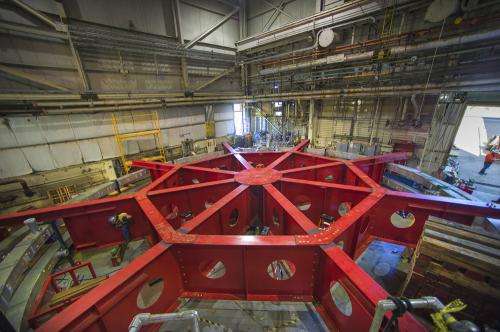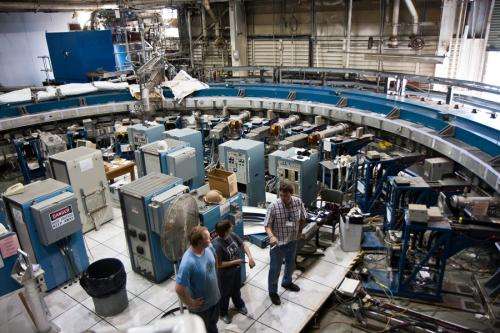Massive particle storage ring to begin 3,200-mile trek on Sunday

(Â鶹ÒùÔº) —How do you move a 50-foot-wide, circular electromagnet from Long Island to the Chicago suburbs in one piece without flexing or twisting it? Very, very carefully.
On Sunday, June 16, the electromagnet will begin its 3,200-mile land and sea voyage to its new home at the U.S. Department of Energy's (DOE) Fermi National Accelerator Laboratory in Illinois, where it will become the centerpiece of a new experiment called Muon g-2 (pronounced gee-minus-two).
This experiment will study the properties of muons, subatomic particles that live only 2.2 millionths of a second, and its results could open the door to new realms of particle physics.
The magnet was built at the DOE's Brookhaven National Laboratory in New York in the 1990s, where it was used in a similar experiment. The ring is constructed of aluminum and steel, with superconducting coils inside, and it cannot be taken apart or twisted more than a few millimeters without irreparably damaging those coils.
Transporting the electromagnet from Brookhaven to Fermilab will cost 10 times less than building a new one. The magnet will remain inert, exhibiting no magnetic properties, until it is plugged in at Fermilab.
The Muon g-2 team has devised a plan that involves loading the ring onto a specially prepared barge and bringing it down the East Coast, around the tip of Florida and up the Mississippi, Illinois, and Des Plaines rivers to Illinois. Once it arrives in late July, the ring will be attached to a truck built just for the move and driven to Fermilab, traveling over two consecutive nights and using rolling roadblocks to temporarily close sections of the roads.

Road closings and detours will be coordinated with public safety agencies in both states.
The trip begins Sunday morning, as the ring will be moved across the Brookhaven site to a staging area just inside its main gate. On the evening of Monday, June 17, it will be driven down the William Floyd Parkway to the Smith Point Marina, where it will be loaded onto the barge.
Members of the public can follow along on the ring's journey on a new web page launched this week at muon-g-2.fnal.gov/bigmove. The page includes a GPS-powered map that will trace the path of the ring in real time, and a blog that will be updated with images, videos and the most current information about the move.
Public events are also in the planning stages to celebrate the ring's arrival at Fermilab.
"It's not often our neighbors get a ringside seat for something this complex and interesting," said Chris Polly, Muon g-2 project manager for Fermilab. "We're excited to get this move underway."
For more information on the experiment, visit .
More information:
Provided by Fermi National Accelerator Laboratory




















